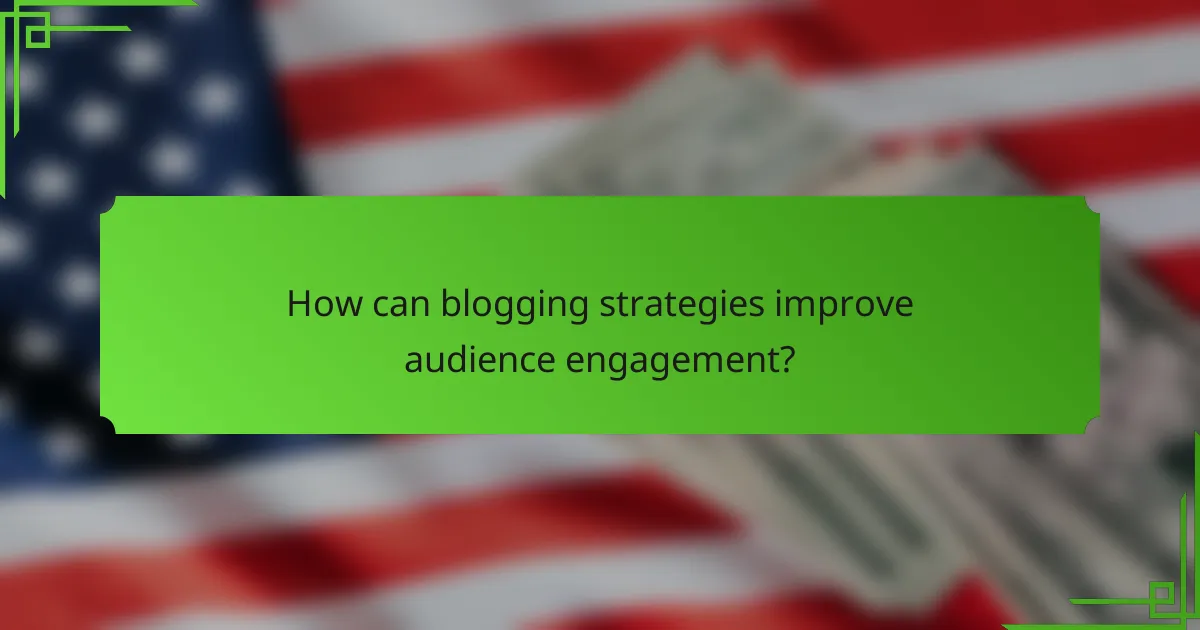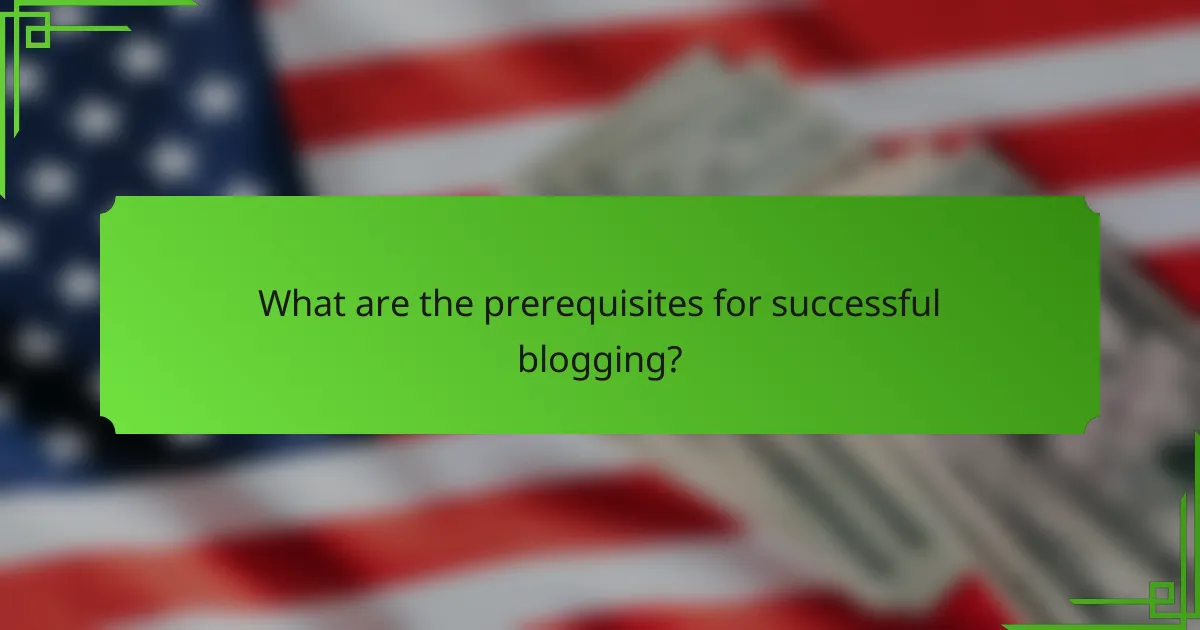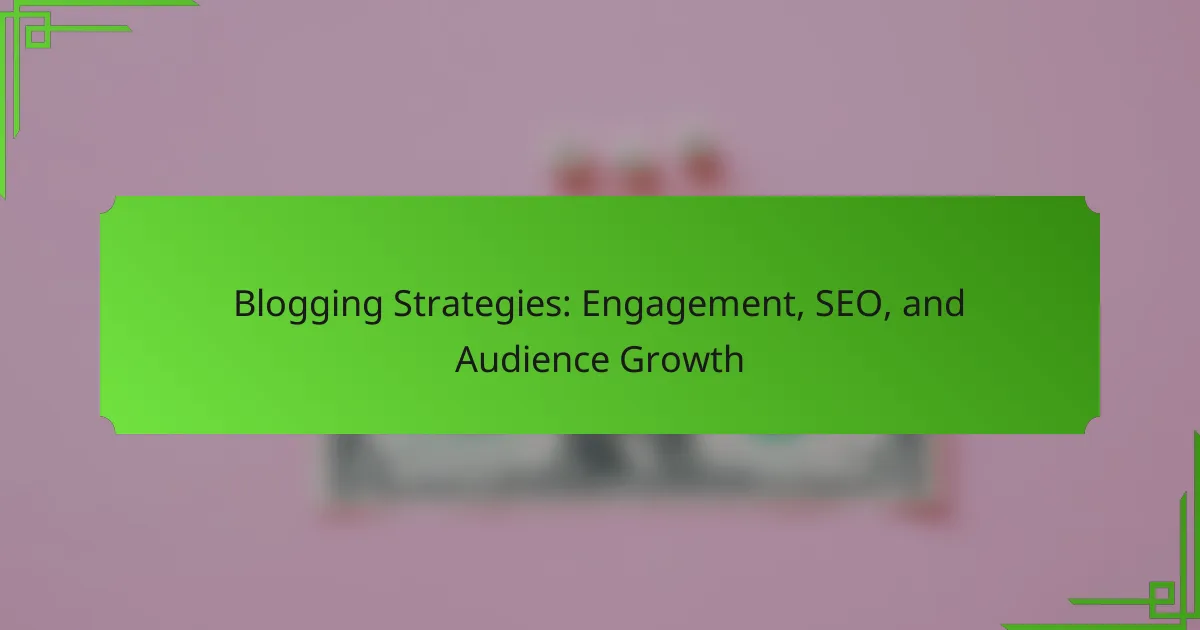In the competitive world of blogging, effective strategies for engagement, SEO, and audience growth are essential for success. By creating interactive content and optimizing for search engines, bloggers can foster meaningful connections with their readers while increasing visibility. Implementing targeted marketing techniques and engaging with online communities further enhances the potential for audience expansion.

How can blogging strategies improve audience engagement?
Blogging strategies can significantly enhance audience engagement by creating interactive and personalized experiences. By focusing on various content formats, tailored communications, and community interactions, bloggers can foster deeper connections with their readers.
Interactive content formats
Interactive content formats, such as quizzes, polls, and surveys, encourage readers to participate actively rather than passively consuming information. These formats can boost engagement by making the content more enjoyable and relatable.
For example, a blog post about travel could include a quiz to help readers determine their ideal vacation destination. This not only keeps readers on the page longer but also provides valuable insights into their preferences.
Personalized email campaigns
Personalized email campaigns can significantly increase engagement by delivering tailored content directly to subscribers. By segmenting your audience based on interests or behaviors, you can send targeted messages that resonate more with each group.
For instance, if a blog covers multiple topics, such as technology and lifestyle, you could send different newsletters focusing on each area to the respective subscriber segments. This approach can lead to higher open rates and click-through rates.
Community building through comments
Encouraging comments on blog posts fosters a sense of community among readers. By responding to comments and facilitating discussions, bloggers can create a welcoming environment that invites further interaction.
To enhance community engagement, consider asking open-ended questions at the end of each post. This invites readers to share their thoughts and experiences, making them feel valued and more likely to return.
Utilizing social media platforms
Social media platforms are vital for promoting blog content and engaging with a broader audience. Sharing blog posts on platforms like Facebook, Twitter, and Instagram can drive traffic and facilitate discussions around your content.
To maximize effectiveness, tailor your posts to each platform’s audience. For example, use eye-catching visuals on Instagram and concise, engaging text on Twitter. Regularly interacting with followers through comments and messages can further strengthen these connections.

What are effective SEO techniques for bloggers?
Effective SEO techniques for bloggers include optimizing content for search engines, improving site visibility, and enhancing user experience. By implementing strategies like keyword research, on-page optimization, and building backlinks, bloggers can significantly increase their organic traffic and audience engagement.
Keyword research tools like Ahrefs
Keyword research tools, such as Ahrefs, help bloggers identify relevant keywords that potential readers are searching for. These tools provide insights into search volume, keyword difficulty, and related terms, allowing bloggers to target the right audience effectively.
When using Ahrefs, focus on finding keywords with a balance of decent search volume and manageable competition. Aim for long-tail keywords, as they often have lower competition and higher conversion rates. For instance, instead of targeting “travel,” consider “budget travel tips for Europe.”
On-page optimization strategies
On-page optimization involves enhancing individual web pages to rank higher and earn more relevant traffic. Key strategies include optimizing title tags, meta descriptions, headers, and content for targeted keywords while ensuring readability and engagement.
Utilize a clear structure with headings (H1, H2, H3) to improve content organization. Incorporate keywords naturally within the text, but avoid keyword stuffing. Additionally, ensure images have alt text and that the site is mobile-friendly, as these factors contribute to better SEO performance.
Building backlinks through guest blogging
Building backlinks is crucial for improving a blog’s authority and search engine ranking. Guest blogging on reputable sites allows bloggers to create high-quality content while earning backlinks to their own site, which boosts credibility and visibility.
When pursuing guest blogging opportunities, focus on niche-relevant websites with a strong domain authority. Craft unique, valuable content that aligns with the host site’s audience. Always include a link back to your blog in the author bio or within the content, ensuring it adds value to the readers.

How can bloggers grow their audience?
Bloggers can grow their audience by implementing targeted strategies that enhance visibility and engagement. This involves leveraging partnerships, utilizing effective content marketing, and actively participating in relevant online communities.
Leveraging influencer partnerships
Partnering with influencers can significantly expand a blogger’s reach. By collaborating with individuals who have established audiences, bloggers can tap into new demographics and gain credibility.
To maximize the impact, choose influencers whose values align with your content. Consider micro-influencers as they often have highly engaged followers and may offer more affordable collaboration options.
When approaching influencers, be clear about mutual benefits, whether through sponsored posts, guest appearances, or social media takeovers.
Utilizing content marketing strategies
Effective content marketing is crucial for audience growth. This includes creating high-quality, valuable content that resonates with your target audience and encourages sharing.
Utilize SEO best practices by researching keywords relevant to your niche. Incorporate these keywords naturally into your posts to improve search engine visibility. Regularly updating your blog with fresh content can also keep your audience engaged.
Consider diversifying your content formats, such as videos, infographics, or podcasts, to cater to different preferences and increase shareability.
Engaging in online forums and communities
Active participation in online forums and communities can help bloggers connect with potential readers. Platforms like Reddit, Quora, or niche-specific forums allow bloggers to share expertise and promote their content organically.
Focus on providing value rather than self-promotion. Answer questions, offer insights, and link to your blog when relevant. This builds trust and encourages users to explore your content further.
Regular engagement in these communities can lead to increased visibility and a loyal following, as users appreciate authentic contributions over blatant advertising.

What metrics should bloggers track for success?
Bloggers should track metrics such as website traffic, engagement rates, and conversion rates to gauge their success. These metrics provide insights into audience behavior and content effectiveness, helping to refine strategies for growth.
Website traffic analysis with Google Analytics
Google Analytics is a powerful tool for tracking website traffic. It provides data on the number of visitors, page views, and session duration, which helps bloggers understand how users interact with their content.
Key metrics to focus on include unique visitors, bounce rate, and traffic sources. For example, a high bounce rate may indicate that visitors are not finding what they expect, prompting a review of content relevance and user experience.
Regularly reviewing these metrics can help identify trends and inform content strategies. Aim to analyze traffic weekly or monthly to stay updated on audience preferences and behavior.
Engagement rates on social media
Engagement rates on social media reflect how well your content resonates with your audience. This includes likes, shares, comments, and overall interactions on platforms like Facebook, Twitter, and Instagram.
To calculate engagement rate, divide the total interactions by the total followers and multiply by 100. A typical engagement rate for blogs might range from 1% to 5%, depending on the niche and audience size.
Monitoring engagement helps identify which content types perform best. Focus on creating shareable content and actively engaging with your audience to boost these rates. Regularly assess your social media performance to adjust your strategies accordingly.

What are the prerequisites for successful blogging?
Successful blogging requires a clear understanding of your target audience and well-defined goals. These elements help shape your content strategy and ensure your blog resonates with readers.
Understanding target audience demographics
Identifying your target audience demographics is crucial for tailoring your content effectively. Consider factors such as age, gender, location, and interests to create relevant posts that engage your readers.
Utilize tools like Google Analytics or social media insights to gather data about your audience. This information can guide your content topics, tone, and even the platforms you choose for promotion.
Setting clear blogging goals
Establishing clear blogging goals helps you measure success and stay focused. Goals can range from increasing website traffic, building an email list, or boosting engagement on social media platforms.
Use the SMART criteria—Specific, Measurable, Achievable, Relevant, Time-bound—to define your objectives. For example, aim to increase your blog traffic by 20% within six months through targeted SEO strategies and social media promotion.

What are the emerging trends in blogging strategies?
Emerging trends in blogging strategies focus on enhancing engagement, optimizing for search engines, and fostering audience growth. Key developments include the integration of multimedia content, personalized experiences, and leveraging social media platforms for broader reach.
Video content integration
Video content integration is becoming essential for bloggers aiming to boost engagement and retention. By incorporating videos, bloggers can convey information more dynamically, catering to diverse audience preferences and increasing the time spent on their pages.
When integrating video, consider the format and length. Short clips of 1-3 minutes tend to perform well, while longer videos can be effective for in-depth tutorials or storytelling. Ensure videos are relevant to your blog topics and enhance the overall user experience.
To maximize the impact of video content, use clear thumbnails, engaging titles, and optimized descriptions. Additionally, consider embedding videos from platforms like YouTube or Vimeo, which can help with SEO and drive traffic back to your blog.
